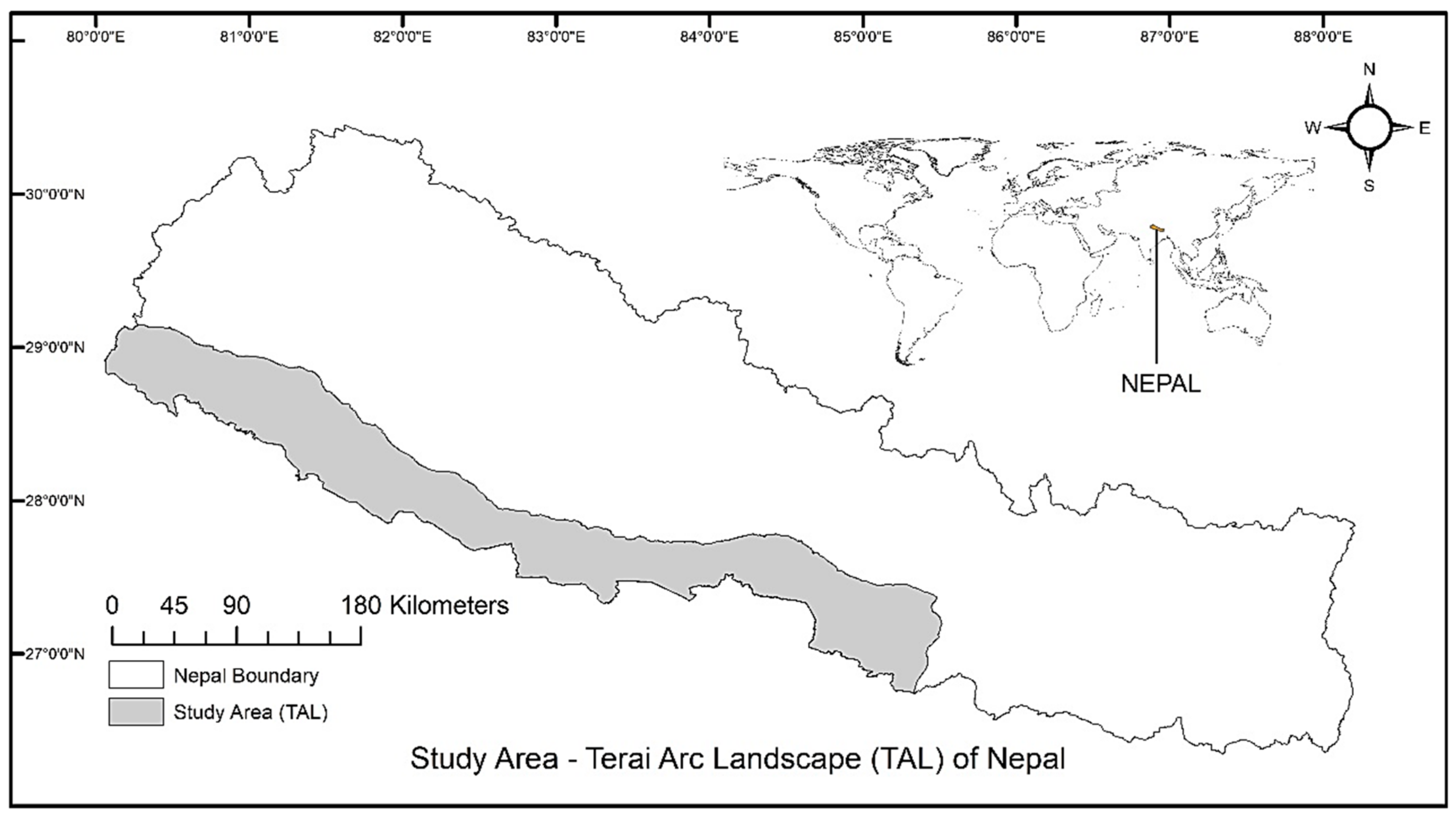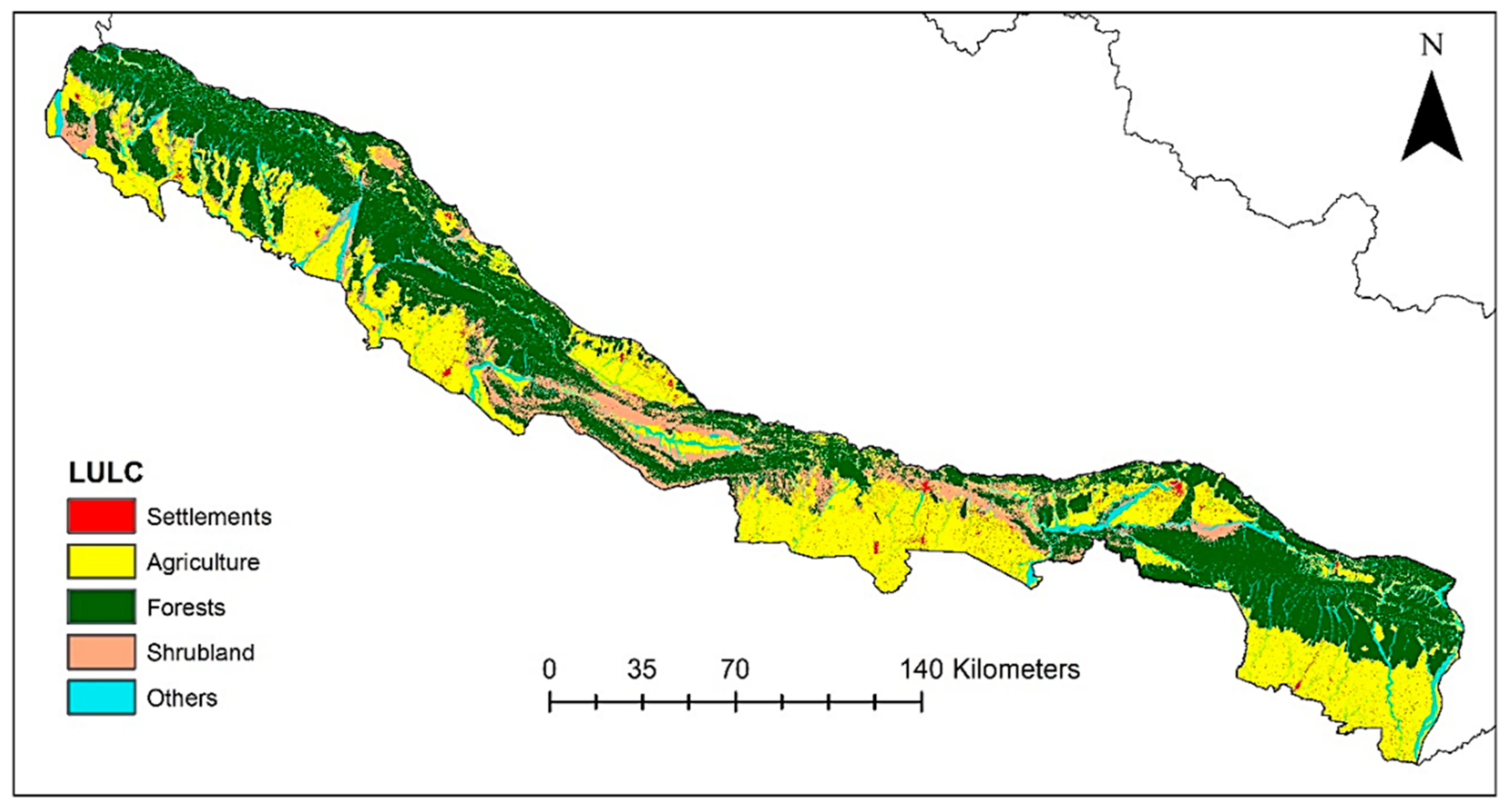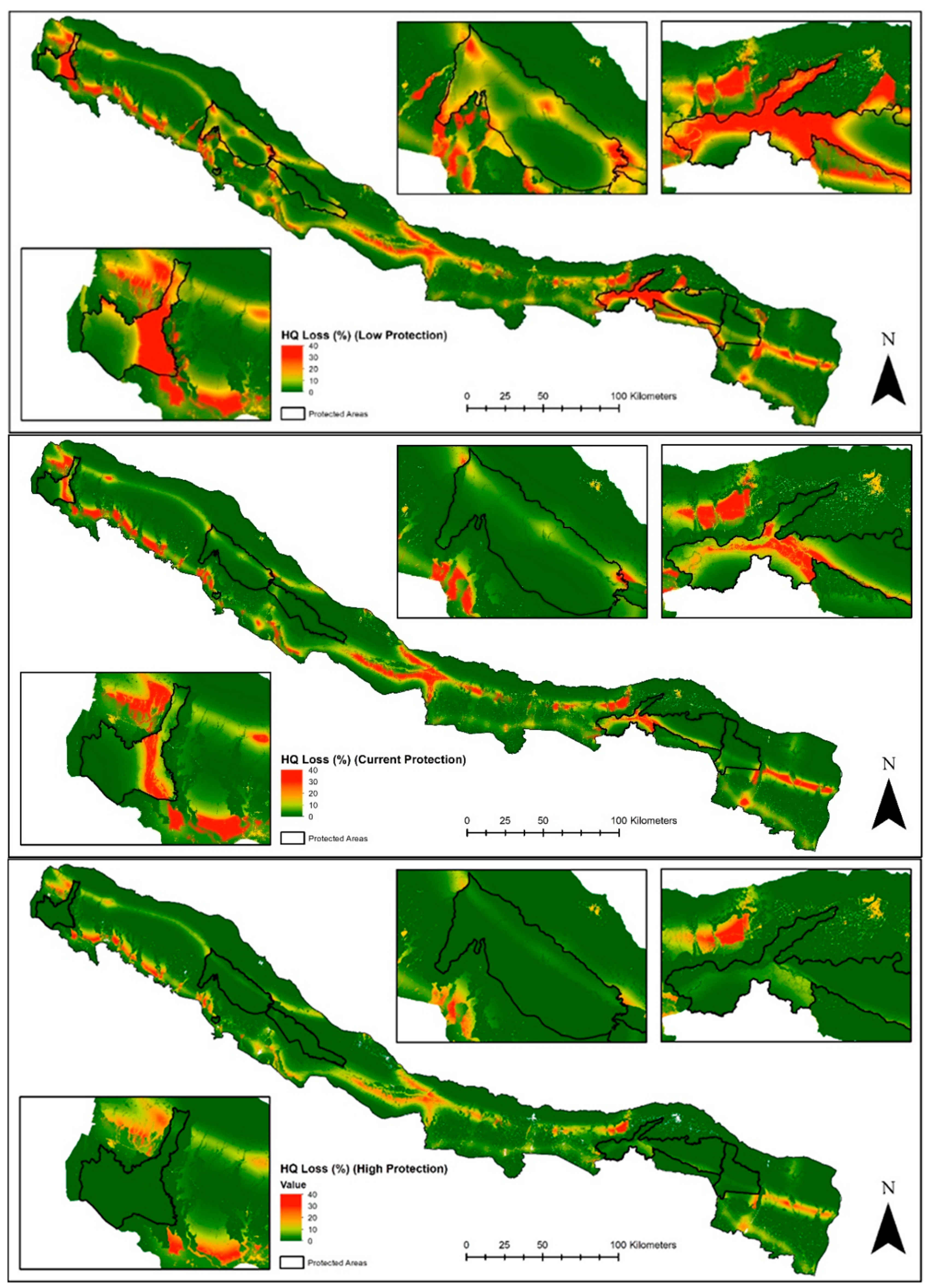Spatial Assessment of the Potential Impact of Infrastructure Development on Biodiversity Conservation in Lowland Nepal
Abstract
:1. Introduction
2. Materials and Methods
2.1. Study Area
2.2. Data Collection and Processing
2.3. GIS Based Modelling Using InVEST
3. Results
4. Discussion and Conclusion
Author Contributions
Funding
Acknowledgments
Conflicts of Interest
Appendix A
| Threats (r) | Maximum Effective Distance of Threat (dr max) (kms) | Weight (wr) | LULC Classes | ||||
|---|---|---|---|---|---|---|---|
| Agriculture | Forest | Built-Up | Shrubland | Others (Waterbody, Wetlands, Barren Lands) | |||
| Habitat Suitability Score (Hj) | |||||||
| 0.3 | 1 | 0 | 0.6 | 0.2 | |||
| Sensitivity of Habitats to Threats (Sjr) | |||||||
| Agriculture | 4 | 0.8 | 0 | 0.7 | 0 | 0.6 | 0.8 |
| Settlements | 5 | 1 | 0.5 | 0.8 | 0 | 0.7 | 0.6 |
| Existing Road Network | 3 | 0.8 | 0.5 | 0.8 | 0 | 0.7 | 0.5 |
| Proposed | |||||||
| Postal Road | 2 | 0.7 | 0.4 | 0.6 | 0 | 0.5 | 0.3 |
| Fast Track | 3 | 0.8 | 0.5 | 0.8 | 0 | 0.7 | 0.4 |
| Railways | 2 | 0.7 | 0.4 | 0.6 | 0 | 0.5 | 0.3 |
| Data | Description |
|---|---|
| LULC raster for 2016 | A LULC raster map for 2016 was produced by using freely available Landsat 8 OLI images. The raster map was classified into 5 LULC classes with a code/id for each land cover type cells. |
| Threat raster | The raster threats to biodiversity were defined as agriculture, primary and secondary roads, rail networks and settlements. Agriculture and settlement maps were acquired through the current LULC maps. The road map was acquired through the Department of Roads and the rail map was acquired through the Department of Railways. |
| Habitat Suitability Score | The habitat suitability scores range from 0 to 1. 0 represents non-habitat land use type, and 1 represents perfect habitat. Habitat suitability score was determined through secondary sources, stakeholder consultation, and expert knowledge. |
| Sensitivity of habitat types of each threat | Sensitivity values range from 0 to 1; where 0 represents no sensitivity to a threat and 1 represents the greatest sensitivity. The score for sensitivity was determined through expert knowledge and secondary literature [37,38,46,47]. |
| Half-saturation constant | The InVEST habitat model uses a half-saturation curve to develop HQ values from habitat degradation scores. To calibrate the value for k the model was run once and the value was set as half of the highest grid-cell degradation level; which is equal to the grid cell degradation score that returns a pixel habitat value [37]. |
References
- MEA. Ecosystems and Human Well-Being: A Framework for Assessment; Island Press: Washington, DC, USA, 2005; ISBN 1-55963-403-0. [Google Scholar]
- Pimm, S.L.; Russell, G.J.; Gittleman, J.L.; Brooks, T.M. The future of biodiversity. Science 1995, 269, 347–350. [Google Scholar] [CrossRef] [PubMed]
- Sala, O.E.; Chapin, F.S., 3rd; Armesto, J.J.; Berlow, E.; Bloomfield, J.; Dirzo, R.; Huber-Sanwald, E.; Huenneke, L.F.; Jackson, R.B.; Kinzig, A.; et al. Global biodiversity scenarios for the year 2100. Science 2000, 287, 1770–1774. [Google Scholar] [CrossRef] [PubMed]
- UNEP. Global Environment Outlook (Geo-5): Environment for the Future We Want; Progress Press: Valletta, Malta, 2012; ISBN 978-92-807-3177-4. [Google Scholar]
- Thomas, C.D.; Cameron, A.; Green, R.E.; Bakkenes, M.; Beaumont, L.J.; Collingham, Y.C.; Erasmus, B.F.N.; de Siqueira, M.F.; Grainger, A.; Hannah, L.; et al. Extinction risk from climate change. Nature 2004, 427, 145–148. [Google Scholar] [CrossRef] [PubMed] [Green Version]
- Butchart, S.H.; Walpole, M.; Collen, B.; van Strien, A.; Scharlemann, J.P.; Almond, R.E.; Baillie, J.E.; Bomhard, B.; Brown, C.; Bruno, J.; et al. Global biodiversity: Indicators of recent declines. Science 2010, 328, 1164–1168. [Google Scholar] [CrossRef] [PubMed]
- Alkemade, R.; van Oorschot, M.; Miles, L.; Nellemann, C.; Bakkenes, M.; Ten Brink, B. Globio3: A framework to investigate options for reducing global terrestrial biodiversity loss. Ecosystems 2009, 12, 374–390. [Google Scholar] [CrossRef]
- Richardson, M.L.; Wilson, B.A.; Aiuto, D.A.S.; Crosby, J.E.; Alonso, A.; Dallmeier, F.; Golinski, G.K. A review of the impact of pipelines and power lines on biodiversity and strategies for mitigation. Biodivers. Conserv. 2017, 26, 1801–1815. [Google Scholar] [CrossRef]
- Laurance, W.F.; Clements, G.R.; Sloan, S.; O’Connell, C.S.; Mueller, N.D.; Goosem, M.; Venter, O.; Edwards, D.P.; Phalan, B.; Balmford, A.; et al. A global strategy for road building. Nature 2014, 513, 229–232. [Google Scholar] [CrossRef] [PubMed]
- Ibisch, P.L.; Hoffmann, M.T.; Kreft, S.; Pe’er, G.; Kati, V.; Biber-Freudenberger, L.; DellaSala, D.A.; Vale, M.M.; Hobson, P.R.; Selva, N. A global map of roadless areas and their conservation status. Science 2016, 354, 1423–1427. [Google Scholar] [CrossRef] [PubMed]
- Trombulak, S.C.; Frissell, C.A. Review of ecological effects of roads on terrestrial and aquatic communities. Conservat. Biol. 2000, 14, 18–30. [Google Scholar] [CrossRef]
- Moran, M.D.; Cox, A.B.; Wells, R.L.; Benichou, C.C.; McClung, M.R. Habitat loss and modification due to gas development in the Fayetteville shale. Environ. Manag. 2015, 55, 1276–1284. [Google Scholar] [CrossRef] [PubMed]
- Jaeger, J.A.; Bowman, J.; Brennan, J.; Fahrig, L.; Bert, D.; Bouchard, J.; Charbonneau, N.; Frank, K.; Gruber, B.; von Toschanowitz, K.T. Predicting when animal populations are at risk from roads: An interactive model of road avoidance behavior. Ecol. Model 2005, 185, 329–348. [Google Scholar] [CrossRef]
- Geneletti, D. Biodiversity impact assessment of roads: An approach based on ecosystem rarity. EIA Rev. 2003, 23, 343–365. [Google Scholar] [CrossRef]
- González, A.; Keneghan, D.; Fry, J.; Hochstrasser, T. Current practice in biodiversity impact assessment and prospects for developing an integrated process. Impact Assess Proj. Apprais. 2014, 32, 31–42. [Google Scholar] [CrossRef]
- Forman, R.T.T.; Sperling, D.; Bissonette, J.A.; Clevenger, A.P.; Cutshall, C.D.; Dale, V.H.; Fahrig, L.; France, R.L.; Heanue, K.; Goldman, C.R.; et al. Road Ecology: Science and Solutions; Island Press: Washington, DC, USA, 2003; ISBN 1559639334. [Google Scholar]
- Laurance, W.F.; Goosem, M.; Laurance, S.G. Impacts of roads and linear clearings on tropical forests. Trends Ecol. Evol. 2009, 24, 659–669. [Google Scholar] [CrossRef] [PubMed] [Green Version]
- Laurance, W.F.; Arrea, I.B. Roads to riches or ruin? Science 2017, 358, 442–444. [Google Scholar] [CrossRef] [PubMed]
- Lechner, A.M.; Chan, F.K.S.; Campos-Arceiz, A. Biodiversity conservation should be a core value of China’s belt and road initiative. Nat. Ecol. Evol. 2018, 2, 408–409. [Google Scholar] [CrossRef] [PubMed]
- Dhakal, M.; Baral, H. Tiger conservation in South Asia: Lessons from terai arc landscapes, nepal. In Proceedings of the 2nd International Conference on Tropical Biology Ecological Restoration in Southeast Asia: Challenges, Gains, and Future Directions, SEAMEO BIOTROP, Bogor, Indonesia, 12–13 October 2016. [Google Scholar]
- Thapa, K.; Wikramanayake, E.; Malla, S.; Acharya, K.P.; Lamichhane, B.R.; Subedi, N.; Pokharel, C.P.; Thapa, G.J.; Dhakal, M.; Bista, A.; et al. Tigers in the terai: Strong evidence for meta-population dynamics contributing to tiger recovery and conservation in the Terai Arc Landscape. PLoS ONE 2017, 12, e0177548. [Google Scholar] [CrossRef] [PubMed]
- Ministry of Forests and Soil Conservation. Strategy and Action Plan 2015–2025, Terai Arc Landscape, Nepal; Ministry of Forests and Soil Conservation: Kathmandu, Nepal, 2015.
- Atkinson, G.; Bateman, I.; Mourato, S. Recent advances in the valuation of ecosystem services and biodiversity. Oxf. Rev. Econ. Policy 2012, 28, 22–47. [Google Scholar] [CrossRef]
- Baral, H.; Keenan, R.J.; Sharma, S.K.; Stork, N.E.; Kasel, S. Economic evaluation of ecosystem goods and services under different landscape management scenarios. Land Use Policy 2014, 39, 54–64. [Google Scholar] [CrossRef]
- Zlinszky, A.; Heilmeier, H.; Balzter, H.; Czúcz, B.; Pfeifer, N. Remote sensing and GIS for habitat quality monitoring: New approaches and future research. Remote Sens. 2015, 7, 7987–7994. [Google Scholar] [CrossRef] [Green Version]
- Corbane, C.; Lang, S.; Pipkins, K.; Alleaume, S.; Deshayes, M.; Millán, V.E.G.; Strasser, T.; Borre, J.V.; Toon, S.; Michael, F. Remote sensing for mapping natural habitats and their conservation status—New opportunities and challenges. Int. J. Appl. Earth Obs. Geoinf. 2015, 37, 7–16. [Google Scholar] [CrossRef]
- Turner, W.; Spector, S.; Gardiner, N.; Fladeland, M.; Sterling, E.; Steininger, M. Remote sensing for biodiversity science and conservation. Trends Ecol. Evol. 2003, 18, 306–314. [Google Scholar] [CrossRef]
- Johnson, M.D. Measuring habitat quality: A review. Condor 2007, 109, 489–504. [Google Scholar] [CrossRef]
- Lengyel, S.; Déri, E.; Varga, Z.; Horváth, R.; Tóthmérész, B.; Henry, P.; Kobler, A.; Kutnar, L.; Babij, V.; Seliškar, A.; et al. Habitat monitoring in Europe: A description of current practices. Biodivers. Conserv. 2008, 17, 3327–3339. [Google Scholar] [CrossRef]
- Johnson, M.D.; Arcata, C. Habitat quality: A brief review for wildlife biologists. Trans. West. Sect. Wildl. Soc. 2005, 41, 31. [Google Scholar]
- Corsi, F.; De Leeuw, J.; Skidmore, A. Modeling species distribution with GIS. In Research Techniques in Animal Ecology, 1st ed.; Boitani, L., Fuller, T., Eds.; Columbia University Press: New York, NY, USA, 2000; pp. 389–434. ISBN 0-231-11340-4. [Google Scholar]
- Sharma, R.; Nehren, U.; Rahman, S.A.; Meyer, M.; Rimal, B.; Seta, G.A.; Baral, H. Modeling land use and land cover changes and their effects on biodiversity in Central Kalimantan, Indonesia. Land 2018, 7, 1–14. [Google Scholar] [CrossRef]
- Baral, H.; Jaung, W.; Bhatta, L.D.; Phuntsho, S.; Sharma, S.; Paudyal, K.; Zarandian, A.; Sears, R.; Sharma, R.; Dorji, T.; et al. Approaches and Tools for Assessing Mountain Forest Ecosystem Services. Available online: http://www.cifor.org/publications/pdf_files/WPapers/WP235Baral.pdf (accessed on 20 July 2018).
- Rimal, B.; Zhang, L.; Keshtkar, H.; Wang, N.; Lin, Y. Monitoring and modeling of spatiotemporal urban expansion and land-use/land-cover change using integrated markov chain cellular automata model. ISPRS 2017, 6, 288. [Google Scholar] [CrossRef]
- Rimal, B.; Zhang, L.; Stork, N.; Sloan, S.; Rijal, S. Urban expansion occurred at the expense of agricultural lands in the tarai region of Nepal from 1989 to 2016. Sustainability 2018, 10, 1341. [Google Scholar] [CrossRef]
- Ministry of Land Resource and Management. Topographical Map; Government of Nepal, Ministry of Land Resource and Management, Survey Department, Topographic Survey Branch: Kathmandu, Nepal, 1995.
- Sharp, R.; Tallis, H.T.; Ricketts, T.; Guerry, A.D.; Wood, S.A.; Chaplin-Kramer, R.; Nelson, E.; Ennaanay, D.; Wolny, S.; Olwero, N.; et al. InVEST 3.4.4 User’s Guide. Available online: http://data.naturalcapitalproject.org/invest-releases/3.4.4.post136+h96058b17dddb/userguide/ (accessed on 20 July 2018).
- Polasky, S.; Nelson, E.; Pennington, D.; Johnson, K.A. The impact of land-use change on ecosystem services, biodiversity and returns to landowners: A case study in the state of minnesota. Environ. Ecol. Econ. 2010, 48, 219–242. [Google Scholar] [CrossRef]
- Ministry of Forests and Soil Conservation. Nepal Fifth National Report to Convention on Biological Diversity; Government of Nepal, Ministry of Forests and Soil Conservation, Environment Division: Kathmandu, Nepal, 2014.
- Nekola, J.C.; White, P.S. The distance decay of similarity in biogeography and ecology. J. Biogeogr. 1999, 26, 867–878. [Google Scholar] [CrossRef]
- Rytwinski, T.; Fahrig, L. The impacts of roads and traffic on terrestrial animal populations. In Handbook of Road Ecology, 1st ed.; van der Ree, R., Smith, D.J., Grilo, C., Eds.; John Wiley & Sons, Ltd.: Hoboken, NJ, USA, 2015; pp. 237–246. ISBN 9781118568170. [Google Scholar]
- Sallustio, L.; De Toni, A.; Strollo, A.; Di Febbraro, M.; Gissi, E.; Casella, L.; Geneletti, D.; Munafò, M.; Vizzarri, M.; Marchetti, M. Assessing habitat quality in relation to the spatial distribution of protected areas in Italy. J. Environ. Manag. 2017, 201, 129–137. [Google Scholar] [CrossRef] [PubMed]
- Brook, B.W.; Sodhi, N.S.; Bradshaw, C.J. Synergies among extinction drivers under global change. Trends Ecol. Evol. 2008, 23, 453–460. [Google Scholar] [CrossRef] [PubMed]
- Kasraian, D.; Maat, K.; Stead, D.; van Wee, B. Long-term impacts of transport infrastructure networks on land-use change: An international review of empirical studies. Transp. Rev. 2016, 36, 772–792. [Google Scholar] [CrossRef]
- Fischer, T.B. The Theory and Practice of Strategic Environmental Assessment: Towards a More Systematic Approach, 1st ed.; Routledge: London, UK, 2007; p. 208. ISBN 1844074528. [Google Scholar]
- Baral, H.; Keenan, R.J.; Sharma, S.K.; Stork, N.E.; Kasel, S. Spatial assessment and mapping of biodiversity and conservation priorities in a heavily modified and fragmented production landscape in North-Central Victoria, Australia. Ecol. Indic. 2014, 36, 552–562. [Google Scholar] [CrossRef]
- Liang, Y.; Liu, L. Simulating land-use change and its effect on biodiversity conservation in a watershed in Northwest China. EHS 2017, 3, 1335933. [Google Scholar] [CrossRef]
- Kuhnert, P.M.; Martin, T.G.; Griffiths, S.P. A guide to eliciting and using expert knowledge in bayesian ecological models. Ecol. Lett. 2010, 13, 900–914. [Google Scholar] [CrossRef] [PubMed]





| S.N. | Land Cover | Description |
|---|---|---|
| 1. | Forests | Land dominated by trees (evergreen broad leaf forest and deciduous forest) |
| 2. | Shrubland | Bush, grasslands, shrub cover, and degraded forests |
| 3. | Agriculture | Land under cultivation of agricultural crops |
| 4. | Built-up | Urban and rural settlements and commercial area |
| 5. | Others | Water bodies, wetlands, barren lands/sand |
| HQ Classes | Existing Protection (S1) | Lower Protection (S2) | Higher Protection (S3) | |||
|---|---|---|---|---|---|---|
| Area (km2) | % Loss | Area (km2) | % Loss | Area (km2) | % Loss | |
| Poor (0–0.2) | - | - | - | - | - | - |
| Low (0.2–0.4) | - | - | - | - | - | - |
| Moderate (0.4–0.6) | −42 | −1 | - | - | −52 | −2 |
| Good (0.6–0.8) | - | - | - | - | - | - |
| High (0.8–1) | −770 | −8 | −1138 | −12 | −584 | −6 |
| Sn. | Protected Area and Buffer Zones | Existing Protection | Lower Protection | Higher Protection |
|---|---|---|---|---|
| Mean (%) HQ Loss | ||||
| 1 | Banke Buffer Zone | 0.42 | 5.48 | 0.02 |
| 2 | Banke National Park | 0.79 | 3.49 | 0.12 |
| 3 | Bardia Buffer Zone | 0.23 | 8.23 | 0.04 |
| 4 | Bardia National Park | 1.99 | 5.78 | 0.54 |
| 5 | Blackbuck Conservation Area | 2.36 | 5.54 | 0.57 |
| 6 | Chitwan Buffer Zone | 0.98 | 8.81 | 0.06 |
| 7 | Chitwan National Park | 4.43 | 10.59 | 1.03 |
| 8 | Parsa Buffer Zone | 0.37 | 7.36 | 0.03 |
| 9 | Parsa National Park | 1.69 | 3.47 | 0.54 |
| 10 | Suklaphanta Buffer Zone | 0.70 | 5.90 | 0.09 |
| 11 | Suklaphanta National park | 5.41 | 13.33 | 0.13 |
© 2018 by the authors. Licensee MDPI, Basel, Switzerland. This article is an open access article distributed under the terms and conditions of the Creative Commons Attribution (CC BY) license (http://creativecommons.org/licenses/by/4.0/).
Share and Cite
Sharma, R.; Rimal, B.; Stork, N.; Baral, H.; Dhakal, M. Spatial Assessment of the Potential Impact of Infrastructure Development on Biodiversity Conservation in Lowland Nepal. ISPRS Int. J. Geo-Inf. 2018, 7, 365. https://doi.org/10.3390/ijgi7090365
Sharma R, Rimal B, Stork N, Baral H, Dhakal M. Spatial Assessment of the Potential Impact of Infrastructure Development on Biodiversity Conservation in Lowland Nepal. ISPRS International Journal of Geo-Information. 2018; 7(9):365. https://doi.org/10.3390/ijgi7090365
Chicago/Turabian StyleSharma, Roshan, Bhagawat Rimal, Nigel Stork, Himlal Baral, and Maheshwar Dhakal. 2018. "Spatial Assessment of the Potential Impact of Infrastructure Development on Biodiversity Conservation in Lowland Nepal" ISPRS International Journal of Geo-Information 7, no. 9: 365. https://doi.org/10.3390/ijgi7090365





